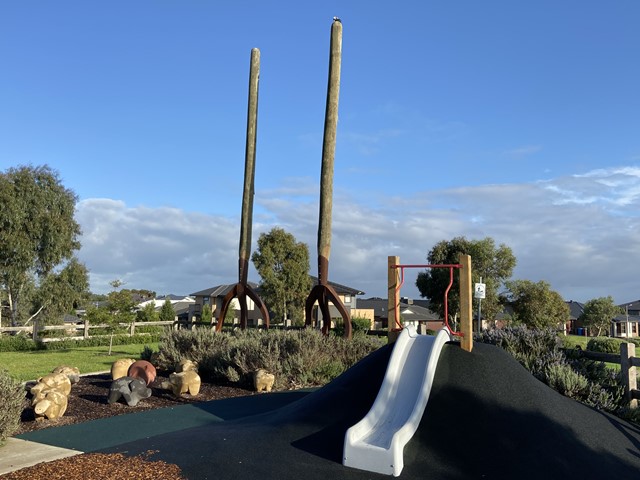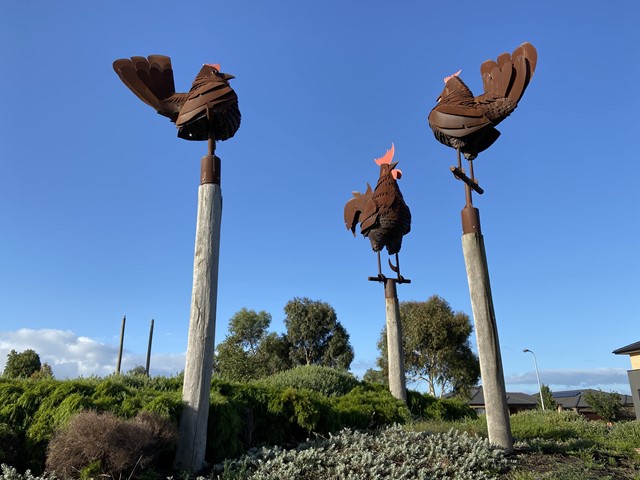Hill Farm Park Playground, Bimberry Circuit, Clyde


This farm themed playground is super cute and is best suited to younger kids. The playground is based around the remnants of the 'Hill Farm' farmhouse which was built in 1875. Within the farmhouse are some tables, BBQs and water tap.
The playground area is set against the background of two giant pitchforks set into the ground and a lot of porky pigs snuffling around in the ground. Play equipment includes a basket swing, a small but steep slide on a mound, difficult rope balance course, stepping stones, two cute wooden springers and a see-saw. Also a seat with wagon wheels.
Down the path are huge sculptures of a rooster and hens on poles. There is a grassy area for play.

Although the play space has been beautifully created to recognise the history of the local area, there isn't enough equipment to keep kids engaged for very long.
Historical Background of the Site:
Pasadena is situated in what was originally the heart of agricultural land north of Western Port Bay in the Shire of Cranbourne.
Prior to European arrival the land was covered in stunted gums, scrubby tea tree, cherry ballad wattles and native grasses.
Hill Farm and the surrounding countryside was part of the 'Mayune' pastoral run, the earliest in the area. Mayune was taken up by the Ruffy Brothers as squatters in 1836 on their arrival from Van Diemen's Land. The brothers established the Cranbourne Inn on their pastoral run and a small community began to be established around the Inn.
By 1852, the Mayune Pastoral run had passed into the ownership of Alexander Cameron, a large landholder across Victoria. Cameron began to subdivide the land of Mayune in the early 1850's. The settlement which had sprung up around the Cranbourne Inn was formally surveyed as the Township of Cranbourne in 1856, and smaller farms were created from the much larger pastoral run.
The first Clyde settlement was established in the 1840's on the Clyde watercourse, which formed the natural boundary between the Mayune and Gin Gin pastoral runs. A church and school were erected by 1875, followed by other buildings. The arrival of the South Eastern Railway, which passed to the south of the Clyde settlement led to new development emerging around the railway station. By 1915 this had become a small village known as Clyde, and the first Clyde settlement became known as Clyde North.
The land on which Hill Farm stands was purchased as a parcel of 152 acres of land by R. Mitchell and J. Close at auction in 1852 for 152 pounds sterling and 2 shillings. The average annual wage at the time was around 20 pounds making the property price equivalent to around 7 years salary.
Mitchell and Close leased the property to a bricklayer, Mr. J. Jennings from the late 1860's, until he purchased a portion of it in 1875. Jennings built the brick residence around 1875, and operated Hill Farm as a small mixed farming enterprise, with a portion of the land devoted to crops and cultivation, a portion grazing stock and the remainder used for a small dairy herd.
Farming - The change of land tenure which came about with the 1860's Land Act enabled small scale agriculture to flourish across Victoria. In the Cranbourne/Clyde area this led to a proliferation of small scale farming industries including dairying, market gardening and orchards.
Hill Farm was at first a small mixed farm, becoming predominately a dairy farm from the late 1800's. The farm supplied fresh milk to local and Melbourne markets on a daily basis.
The farm was mostly self-sufficient; growing vegetables and fruits in the cottage gardens and keeping chickens for eggs and animals such as pigs, cows and sheep for meat. The water for the cottage was sourced from a nearby underground well.
What is this Structure? - Built in 1875, this structure is what remains of the 'Hill Farm' farmhouse, which was a modest four-room brick cottage with later timber additions, and a split shingle clad hip roof. The timber additions, verandah and three walls have been removed from the cottage, but the facade and room remain.
Why is it significant? - This shelter, the remains of the farmhouse of Hill Farm is all that remains of the small subsistence and dairy farm which was located here from the mid nineteenth century. Small farms with simple, well constructed residences and farmyards were once common features in the Clyde and Cranbourne area, but have become rare with the passing of time. This cottage, and its setting within the Hill Farm Park demonstrates the domestic setting of the small scale farm during this period, which are such an important part of the Clyde's rich farming history.
Who built the Cottage? - It is believed that Joseph Jennings, a bricklayer, built the cottage around 1875. Jennings had leased two adjacent lots of land on this site from the 1860's. In 1875 he purchased a portion of the land, and constructed the four room brick cottage and the brick well nearby. The original cottage was constructed of locally made bricks, with hessian sacking covering the walls and ceiling (rather than plaster). The roof was constructed of rough bush poles acting as the rafters and bearers for the roof, and the hipped roof was clad in hand split timber shingles cut from local trees. Although modest, the building was well crafted and comfortable, lasting well into the twenty first century.
Who last lived in the Cottage? - The last people to live at Hill Farm were the Pitman family, consisting of seven family members. At the time the cottage included a timber extension on the southern wall and a verandah extending around the whole building. At its largest the cottage consisted of 3 bedrooms, a kitchen and scullery, living area and outhouse toilet. Water was never connected to the cottage. Rather, fresh water was taken from the nearby well for drinking, cooking, bathing and washing. The Pitman family left Hill Farm in the 1950's, and the cottage has been unoccupied since that time, although the land was still used for farming until around 2010.
Photos:
Location
415 Bimberry Circuit, Clyde 3978 View Map








